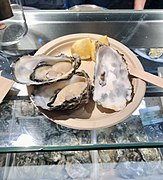
Oyster
Oyster is the common name for a number of different families of salt-water bivalve molluscs that live in marine or brackish habitats. In some species, the valves are highly calcified, and many are somewhat irregular in shape. Many, but not all oysters, are in the superfamily Ostreoidea.
For other uses, see Oyster (disambiguation).Some types of oysters are commonly consumed (cooked or raw), and in some locales, they are regarded as a delicacy. Some types of pearl oysters are harvested for the pearl produced within the mantle. Others such as the translucent Windowpane oysters, are harvested for their shells.
Etymology[edit]
The word oyster comes from Old French oistre, and first appeared in English during the 14th century.[1] The French derived from the Latin ostrea, the feminine form of ostreum,[2] which is the latinisation of the Ancient Greek ὄστρεον (ostreon) 'oyster'.[3] Compare ὀστέον (osteon) 'bone'.[4]
Types[edit]
True oysters[edit]
True oysters are members of the family Ostreidae. This family includes the edible oysters, which mainly belong to the genera Ostrea, Crassostrea, Ostreola, Magallana, and Saccostrea. Examples include the European flat oyster, eastern oyster, Olympia oyster, Pacific oyster, and the Sydney rock oyster. Ostreidae evolved in the Early Triassic epoch: The genus Liostrea grew on the shells of living ammonoids.[5]
Anatomy[edit]
Oysters breathe primarily via gills. In addition to their gills, oysters can exchange gases across their mantles, which are lined with many small, thin-walled blood vessels. A small, three-chambered heart, lying under the adductor muscle, pumps colorless blood to all parts of the body. At the same time, two kidneys, located on the underside of the muscle, remove waste products from the blood. Their nervous system includes two pairs of nerve cords and three pairs of ganglia. There is no evidence that oysters have a brain.
While some oysters have two sexes (European oyster and Olympia oyster), their reproductive organs contain both eggs and sperm. Because of this, it is technically possible for an oyster to fertilize its own eggs. The gonads surround the digestive organs, and are made up of sex cells, branching tubules, and connective tissue.
Once her millions of eggs are fertilized, the female discharges them into the water. The larvae develop in about six hours and exist suspended in the water column as veliger larvae for two to three weeks before settling on a bed and reaching sexual maturity within a year.
Feeding[edit]
Oysters are filter feeders, drawing water in over their gills through the beating of cilia. Suspended plankton and non-food particles are trapped in the mucus of a gill, and from there are transported to the mouth, where they are eaten, digested, and expelled as feces or pseudofeces that fall to the bottom and remain out of the water column. Oysters feed most actively at temperatures ranging from the high 60s to the high 70s (20–26 °C).[8] Under ideal laboratory conditions, an oyster can filter up to 190 L (50 US gal) of water per day. Under average conditions, mature oysters filter 11–45 L (3–12 U.S. gal). Chesapeake Bay's once-flourishing oyster population historically filtered excess nutrients from the estuary's entire water volume every three to four days. As of 2008 it was estimated that a complete cycle would take nearly a year.[9]
Nutrient cycling[edit]
Bivalves, including oysters, are effective filter feeders and can have large effects on the water columns in which they occur.[14] As filter feeders, oysters remove plankton and organic particles from the water column.[15] Multiple studies have shown individual oysters are capable of filtering up to 190 litres (42 imp gal; 50 US gal) of water per day, and thus oyster reefs can significantly improve water quality and clarity.[16][17][18][19] Oysters consume nitrogen-containing compounds (nitrates and ammonia), phosphates, plankton, detritus, bacteria, and dissolved organic matter, removing them from the water.[20] What is not used for animal growth is then expelled as solid waste pellets, which eventually decompose into the atmosphere as nitrogen.[21] In Maryland, the Chesapeake Bay Program had implemented a plan to use oysters to reduce the amount of nitrogen compounds entering the Chesapeake Bay by 8,600 t (9,500 short tons) per year by 2010.[22] Several studies have shown that oysters and mussels have the capacity to dramatically alter nitrogen levels in estuaries.[23][24][25] In the U.S., Delaware is the only East Coast state without aquaculture, but making aquaculture a state-controlled industry of leasing water by the acre for commercial harvesting of shellfish is being considered.[26] Supporters of Delaware's legislation to allow oyster aquaculture cite revenue, job creation, and nutrient cycling benefits. It is estimated that one acre (0.40 ha) can produce nearly 750,000 oysters, which could filter between 57,000 to 150,000 m3 (2.0–5.3 million cu ft) of water daily.[26] Also see nutrient pollution for an extended explanation of nutrient remediation.
Ecosystem services[edit]
As an ecosystem engineer, oysters provide supporting ecosystem services, along with provisioning, regulating and cultural services. Oysters influence nutrient cycling, water filtration, habitat structure, biodiversity, and food web dynamics.[27] Oyster reef habitats have been recognized as green infrastructure for shoreline protection.[28] Assimilation of nitrogen and phosphorus into shellfish tissues provides an opportunity to remove these nutrients from the water column.[29][30][31] In California's Tomales Bay, native oyster presence is associated with higher species diversity of benthic invertebrates.[32][33] The ecological and economic importance of oyster reefs has become more acknowledged, restoration efforts have increased.[34]
Oysters are subject to various diseases which can reduce harvests and severely deplete local populations. Disease control focuses on containing infections and breeding resistant strains, and is the subject of much ongoing research.
Some oysters also harbor bacterial species which can cause human disease; of importance is Vibrio vulnificus, which causes gastroenteritis, which is usually self-limiting, and cellulitis. Cellulitis can be severe and rapidly spreading, requiring antibiotics, medical care, and in some severe cases amputation. It is usually acquired when the contents of the oyster come in contact with a cut skin lesion, as when shucking an oyster.

![Fried oyster with egg and flour is a common dish in Malaysia[57] and Singapore.](http://upload.wikimedia.org/wikipedia/commons/thumb/9/91/FriedOyster.JPG/240px-FriedOyster.JPG)
![Deep fried oyster in Japan.[58]](http://upload.wikimedia.org/wikipedia/commons/thumb/a/a1/Deep_fried_oysters_by_Kossy%40FINEDAYS_in_Akabane.jpg/240px-Deep_fried_oysters_by_Kossy%40FINEDAYS_in_Akabane.jpg)

